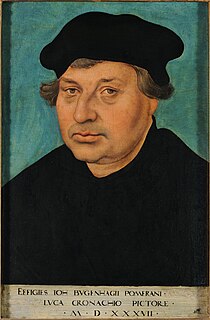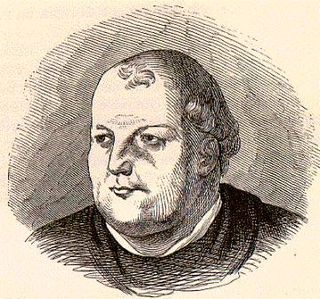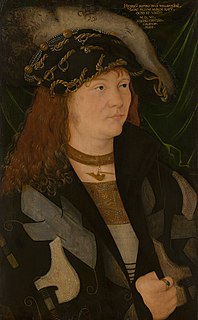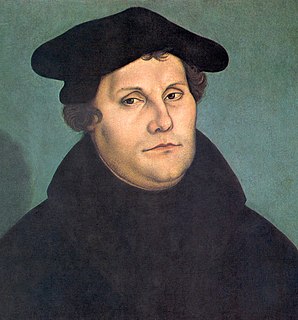
The Reformation was a movement in Western Christianity in 16th-century Europe. Although the Reformation is usually considered to have started with the publication of the Ninety-five Theses by Martin Luther in 1517, there was no schism between the Catholics and the nascent Lutheran branch until the 1521 Edict of Worms. The edicts of the Diet condemned Luther and officially banned citizens of the Holy Roman Empire from defending or propagating his ideas. The end of the Reformation era is disputed, it could be considered to end with the enactment of the confessions of faith which began the Age of Orthodoxy. Other suggested ending years relate to the Counter-Reformation, the Peace of Westphalia, or that it never ended since there are still Protestants today.

Frederick III, also known as Frederick the Wise, was Elector of Saxony from 1486 to 1525, who is mostly remembered for the worldly protection of his subject Martin Luther.

Katharina von Bora, after her wedding Katharina Luther, also referred to as "die Lutherin", was the wife of Martin Luther, German reformer and a seminal figure of the Protestant Reformation. Beyond what is found in the writings of Luther and some of his contemporaries, little is known about her. Despite this, Katharina is often considered one of the most important participants in the Reformation because of her role in helping to define Protestant family life and setting the tone for clergy marriages.

Johannes Bugenhagen, also called Doctor Pomeranus by Martin Luther, introduced the Protestant Reformation in the Duchy of Pomerania and Denmark in the 16th century. Among his major accomplishments was organization of Lutheran churches in Northern Germany and Scandinavia. He has also been called the second Apostle of the North.

Justus Jonas, the Elder, or simply Justus Jonas, was a German Lutheran theologian and reformer. He was a Jurist, Professor and Hymn writer. He is best known for his translations of the writings of Martin Luther and Philipp Melanchthon. He accompanied Martin Luther in his final moments.

Johann von Staupitz, O.S.A. was a Catholic theologian, university preacher, and Vicar General of the Augustinian friars in Germany, who supervised Martin Luther during a critical period in his spiritual life. Martin Luther himself remarked, "If it had not been for Dr. Staupitz, I should have sunk in hell." Although he remained Catholic, died as a Benedictine monk and had repudiated the Reformation, he is commemorated on 8 November as a priest in the Calendar of Saints of the Lutheran Church–Missouri Synod.

On the Jews and Their Lies is a 65,000-word antisemitic treatise written in 1543 by the German Reformation leader Martin Luther.

Hersfeld Abbey was an important Benedictine imperial abbey in the town of Bad Hersfeld in Hesse, Germany, at the confluence of the rivers Geisa, Haune and Fulda.

Lutheranism as a religious movement originated in the early 16th century Holy Roman Empire as an attempt to reform the Roman Catholic Church. The movement originated with the call for a public debate regarding several issues within the Catholic Church by Martin Luther, then a professor of Bible at the young University of Wittenberg. Lutheranism soon became a wider religious and political movement within the Holy Roman Empire owing to support from key electors and the widespread adoption of the printing press. This movement soon spread throughout northern Europe and became the driving force behind the wider Protestant Reformation. Today, Lutheranism has spread from Europe to all six populated continents.

The theology of Martin Luther was instrumental in influencing the Protestant Reformation, specifically topics dealing with Justification by Faith, the relationship between the Law and the Gospel, and various other theological ideas. Although Luther never wrote a "systematic theology" or a "summa" in the style of St. Thomas Aquinas, many of his ideas were systematized in the Lutheran Confessions.

Martin Luther is a 1953 American–West German film biography of Martin Luther. It was directed by Irving Pichel,, and stars Niall MacGinnis as Luther. It was produced by Louis de Rochemont and RD-DR Corporation in collaboration with Lutheran Church Productions and Luther-Film-G.M.B.H.
Martin Luther (1483–1546) was a German professor of theology, priest and seminal leader of the Reformation. However, despite his importance as a figure in the development of Protestant theology, his positions on Judaism continue to be controversial. These changed dramatically from his early career, where he showed concern for the plight of European Jews to his later years, when embittered by his failure to convert them to Christianity, he became outspokenly antisemitic in his statements and writings. Recent historical studies have focused on Luther's influence on modern antisemitism, with a particular focus on Adolf Hitler and the Nazis.

Luther's Marian theology is derived from his views of Mary, the mother of Jesus. It was developed out of the deep Christian Marian devotion on which he was reared, and it was subsequently clarified as part of his mature Christocentric theology and piety. Lutherans hold Mary in high esteem. Martin Luther dogmatically asserted what he considered firmly established biblical doctrines like the divine motherhood of Mary while adhering to pious opinions of the Immaculate Conception and the perpetual virginity of Mary along with the caveat that all doctrine and piety should exalt and not diminish the person and work of Jesus Christ. By the end of Luther's theological development, his emphasis was always placed on Mary as merely a receiver of God's love and favor. His opposition to regarding Mary as a mediatrix of intercession or redemption was part of his greater and more extensive opposition to the belief that the merits of the saints could be added to those of Jesus Christ to save humanity.

The Reformation in Denmark–Norway and Holstein was the transition from Catholicism to Lutheranism in the realms ruled by the Danish-based House of Oldenburg in the first half of the sixteenth century. After the break-up of the Kalmar Union in 1521/1523, these realms included the kingdoms of Denmark and Norway and the Duchies of Schleswig and Holstein, whereby Denmark also extended over today's Gotland and Øsel in Estonia.

Lutheran scholasticism was a theological method that gradually developed during the era of Lutheran Orthodoxy. Theologians used the neo-Aristotelian form of presentation, already popular in academia, in their writings and lectures. They defined the Lutheran faith and defended it against the polemics of opposing parties.

Henry V, Duke of Mecklenburg, nicknamed the Peaceful, was the reigning Duke of Mecklenburg in the region Mecklenburg-Schwerin, the son of Duke Magnus II and Sophie of Pomerania-Stettin.
Martin Luther Stoever was a United States Lutheran educator and writer. His biographical work earned him the title of “The Plutarch of the Lutheran Church.”

St. Augustine's Monastery in Erfurt in central Germany, is a former church and monastery complex dating from the 13th century. The site is almost one hectare in size. It was built by Augustinian monks, an order of the Catholic Church. It is most well known as the former home of Martin Luther (1483-1546), the father of the Reformation, who lived there as a monk from 1505 until 1511.















